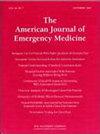八年来美国急诊科心脏骤停护理和死亡率的趋势
IF 2.7
3区 医学
Q1 EMERGENCY MEDICINE
引用次数: 0
摘要
心脏骤停在急诊科(ED)是一个罕见的事件。之前的研究使用了专门的心脏骤停登记处,但很少有人利用电子医疗保健供应商的“大数据”来分析被排除在登记处之外的患者的护理趋势。方法:这是一项回顾性队列研究,研究对象是来自Epic Cosmos数据库的2.77亿例心脏骤停的急诊科成年患者。纳入与急诊科心脏骤停对应的ICD-10编码患者。结果包括心脏骤停的发生率、死亡率、代码长度和体外膜氧合(ECMO)。资料采用95%置信区间(CI)的比值比进行比较。结果2016年1月1日至2023年12月31日就诊的196834,283例急诊科患者中,心脏骤停429,917例(0.22%),急诊科死亡197,233例(45.88%),急诊科心脏骤停发生率(0.26%)和死亡发生率(55.70%)在2020年达到高峰。心脏骤停在男性和老年患者中更为常见,在00:00-05:59之间,在周末,在南方(p <;0.001)。中位编码长度为10-20分钟。只有0.29%的心脏骤停患者接受了ECMO。与2016年相比,密码长度>;2023年的90min和ECMO分别是前者的1.43倍(95% CI 1.32 ~ 1.54)和3.58倍(95% CI 2.41 ~ 5.31)。结论虽然心脏骤停在急诊科是一个罕见的事件,但几乎有一半的患者在急诊科死亡。心脏骤停后ECMO的使用正在增加,但仍然很低。需要进一步的研究来减轻这些护理差异。本文章由计算机程序翻译,如有差异,请以英文原文为准。
Trends in cardiac arrest care and mortality in United States emergency departments over eight years
Introduction
Cardiac arrest in the emergency department (ED) is a rare event. Prior studies have used dedicated cardiac arrest registries, but few have leveraged “big data” from electronic healthcare vendors to analyze trends in the care of patients excluded from registries.
Methods
This was a retrospective cohort study of adult patients in the ED with cardiac arrest from Epic Cosmos, a database with 277 million patients. Patients with ICD-10 codes corresponding to cardiac arrest in the ED were included. Outcomes included the incidence of cardiac arrest, mortality, code length, and extracorporeal membrane oxygenation (ECMO). Data were compared using odds ratio with 95 % confidence intervals (CI).
Results
Among 196,834,283 ED visits from 1/1/2016 to 12/31/2023, there were 429,917 (0.22 %) cardiac arrests and 197,233 (45.88 %) patients who died in the ED. The incidence of cardiac arrest (0.26 %) and death in the ED (55.70 %) peaked in 2020. Cardiac arrest was more common in male and older patients, between 00:00–05:59, on weekends, and in the South (p < 0.001). The median code length was 10–20 min. Only 0.29 % of cardiac arrest patients received ECMO. Compared to 2016, the odds of a code length > 90 min and ECMO in 2023 were 1.43 (95 % CI 1.32–1.54) and 3.58 (95 % CI 2.41–5.31) times greater, respectively.
Conclusion
Although cardiac arrest in the ED is a rare event, almost half of patients die in the ED. The use of ECMO after cardiac arrest is increasing but remains low. Further research is needed to mitigate these differences in care.
求助全文
通过发布文献求助,成功后即可免费获取论文全文。
去求助
来源期刊
CiteScore
6.00
自引率
5.60%
发文量
730
审稿时长
42 days
期刊介绍:
A distinctive blend of practicality and scholarliness makes the American Journal of Emergency Medicine a key source for information on emergency medical care. Covering all activities concerned with emergency medicine, it is the journal to turn to for information to help increase the ability to understand, recognize and treat emergency conditions. Issues contain clinical articles, case reports, review articles, editorials, international notes, book reviews and more.

 求助内容:
求助内容: 应助结果提醒方式:
应助结果提醒方式:


